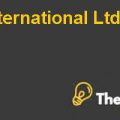Samsung Electronics Company: Global Marketing Case Study Solution
4 P’s of Marketing
Product
Samsung offers quality products and has a quite rich portfolio which caters to different segments. Most of the products are in the top three of their respective industries. LCD and mobile phones are the biggest products of Samsung, whereas DRAM is also not far behind in comparison of them. Following is the product line of Samsung:
- LCD / TV
- Laptops
- Mobile phones
- Air conditioner
- Personal computers
- Hard drives
- Washing machines
- Refrigerators
- Cameras
- Microwaves
- Flash memory
- DRAM
Price
Samsung uses both market competitive and market skimming pricing strategies for its wide variety of products. In competitive pricing it adjusts the price according to the competition in order to gain advantage, whereas, it uses market skimming strategy where the product has an added value and by selling a few products it can reach break-even.
Place
It has one of the best supply chain networks, with retail distributors, their own sole distributors, E commerce channels like Amazon etc. All its products are timely supplied to the selling place / delivered to the customers directly in case of online order.
Promotion
It wasn’t a well-known company outside of Korea until 1993. But the management initiative taken by their CEO has pushed them to market more efficiently outside the borders and now it has entered the league of top 25 companies in the world in just 9 years. This is a remarkable achievement despite the ongoing arguments among the managers about adopting marketing practices. It uses both offline & online channels of promotion to market their products. Paid product advertisements, social promotion and digital advertisements are uses to create awareness about Samsung products.
Value Chain Analysis
It’s an analytical framework for identifying business activities that add value or competitive advantage for the company.
Inbound Logistics
It has one of the most efficient and effective supply chain network and has over 2700 suppliers across various industries around the world. Almost 80% of which is based in Asia and the remaining around the world. For its inbound logistics it owns various logistics firms as it subsidiaries. It looks after its suppliers and creates a harmonious relationship with them and even reduced their payment cycles to boost this relationship further which adds value to their chain network.
Operations
Samsung’s core competency is its mass manufacturing it produces 90% of its products in-house. Divided into three different divisions its operations are namely IT & Mobile Communications, Device Solutions and Consumer Electronics. It is maintaining operation hubs worldwide to further add value to its value chain network.
Outbound Logistics
Its outbound logistics system performance is one of the main reasons Samsung is able to compete with Apple. Samsung’s own Electronic Logitec system plays a major role in the outbound logistics operations. It even performs the tasks of collection of payment, settling insurance claims, etc. on behalf of Samsung.
Marketing and Sales
Attracting target customer attention towards the product is done through marketing and sales to communicate with them the value and competitive advantage the product offers. Samsung advertising budget is continually on the rise since they started their repositioning internationally and will continue to do so as they are continuously looking to expand and invest in high potential growth markets. The budget is spent on events, print and media advertisements, public relations etc.
Samsung Service
Samsung put their customers at the top and continuously strive to deliver un match able customer service standards. As after sales service is becoming extremely important to keep customers happy and engaged, they even conduct surveys through third parties to find out their customer’s feedback and implement it in the positive way to reduce or if possible completely eliminate their customer issues. By adding a direct support line to contact them 24 hours they have further increased the added value of Samsung service.
Segmentation
Samsung has diversified market segmentation, based upon its provision of wide range of products to large number of consumers. Samsung target customer segments can be divided into 3 categories i.e. Samsung IT and Mobile Communications, Samsung Consumer Electronics and Samsung Device solutions.
Geographic
Samsung geographic segmentation is based upon two criteria i.e. region and density. Samsung serves about 80 countries worldwide with its products provided to Urban as well as Rural areas of the country. The Samsung is also growing its global presence and the company’s flexibility in locating its plants encourages global expansion of Samsung.
Demographic
The demographic segmentation of Samsung is based upon gender, age, life-cycle stage and occupation. Samsung produces products that can be used by both males and females. The target customers for Samsung IT and mobile communication products have an age range of 18-65 with majority at a young or newly married life cycle stage. They are mostly students, employees and professionals. Apart from it, Samsung Consumer Electronics are targeted to a customer segment with an age range of 25-65. They are mostly professionals and employees. However Samsung Device Solutions are targeted at students, employees and professionals with an age range of 25-65.
Psycho graphic
The psycho graphic segmentation of Samsung s based upon the social class and the life style of the consumer. Samsung target customers on the basis of social class are mainly upper middle, middle and working class customers, as Samsung sell products like cell phones not much cheaper i.e. Motorola as well as not much expensive i.e. Apple. It provides quality products to middle level consumers at a slightly high price than others targeting the same segment.
Behavioural
Samsung majority target customers have unique behavioural attributes. It has customers with an ambitious, trendy and determined personality with moderate level of loyalty towards the brand. Its customers have some degree of shift towards other renowned brands i.e. Apple. The majority of Samsung customers want quality as well as cost control. They are attracted towards Samsung because of its moderate prices with an extent of quality.
Quantitative Analysis
Sales of Samsung has increased astonishingly from 16 billion $ in 1997 to 44.6 billion $ in 2002, and the net profit of .48 billion $ to 5.9 billion $. It has also reduced its debt from 15 billion $ to 4.6 billion $. Digital media is the largest selling category of Samsung with sales of 13.9 billion $, whereas, Telecommunication and Semiconductors sectors both reached 11 billion $ in sales. Revenues / sales are increasing but net profit is not increasing accordingly because of the high overhead cost. New expansions and hiring’s were the main reason of the increase in the overhead costs, with china currently not providing any profit to Samsung, but there is so much potential in the current market with 75 % yet to be explored.......
This is just a sample partical work. Please place the order on the website to get your own originally done case solution.













